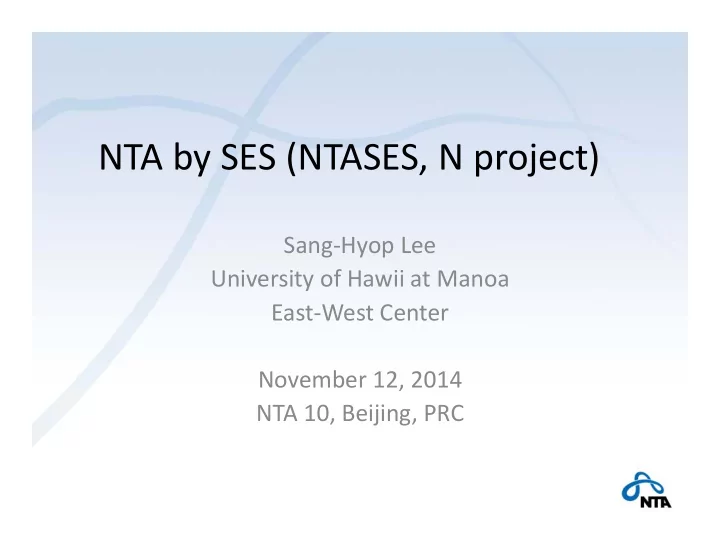

NTA by SES (NTASES, N project) Sang ‐ Hyop Lee University of Hawii at Manoa East ‐ West Center November 12, 2014 NTA 10, Beijing, PRC
Outline • What is NTA by SES? • How to measure? • What are the major challenges? • See some results
SES? • Gender + time use • Income/consumption level • (Parents’) education • Urban vs. rural (+ time use?) • Region • Formal vs. informal sector • Extended household vs. nuclear household • Ethnicity/race/immigrants • Marital status
NTA and SES • What: Disaggregate NTA by household or individual characteristics • Why: SES is an important analitical dimension in many countries – SES is highly associated with many other social, economic and demographic variables – Large heterogeneity in public and private flows within age groups – Intergenerational transmission of inequality • How: Estimate NTA by SES
How to do it? Step 1. Just construct NTA a) And allocate values based on individual characteristics (if you can) b) And allocate values based on household characteristics (if you can) E.g. 1) gender E.g. 2) household head education, rural vs. urban E.g. 3) income, consumption
Annual consumption by education of household head (Chile, 2007)
Household characteristics? (disaggregation of data) 1) Total household income (labor earnings, self ‐ employment income, business revenue, asset income, transfer income) 2) Per capita household income 3) Equivalence ‐ scale ‐ based per capita household income/consumption 4) Per capita or total household consumption
Macro control problem • If you cannot assign individual or household characteristics, then you need separate macro control by SES e.g, tax profiles and government asset allocation—can still assign based on micro survey data share
Data issues • Constructing NTA requires individual or household micro ‐ survey data sets • A good survey data set has the properties of: – Extent: It has the variables of interest at a certain level of detail – Reliability: The variables are measured without error – Validity: The data set is representative
Reliability: Measurement error • Non response rate by SES (representative) • Response error – Respondents do not know what is required – Incentive to understate/overstate – Recall bias: Related to period of survey – Coding error: Using wrong/different reporting units • Reporting error: Heaping or outliers • Discrepancy between aggregate value and individual value 11
Brazil: What funds consumption? Among elderly of any SES and children of low SES = public transfers Source: Turra & Queiroz
Labor income profiles by residence and per capita household income (China, 2009) 45000 70000 40000 60000 35000 50000 30000 40000 25000 RMB RMB 20000 30000 15000 20000 10000 10000 5000 0 0 0 5 10 15 20 25 30 35 40 45 50 55 60 65 70 75 80 85 90 0 5 10 15 20 25 30 35 40 45 50 55 60 65 70 75 80 85 90 Age Age Urban Rural quartile 1 quartile 2 quartile 3 quartile 4 Source: Shen and Lee (2014)
Labor income profiles by formal vs. informal sector (India, 2004–05) Source: Narayana (2014)
Public education profiles by residence and per capita household income (China, 2009) 5000.0 6000 4500.0 5000 4000.0 3500.0 4000 3000.0 RMB 2500.0 3000 2000.0 2000 1500.0 1000.0 1000 500.0 0.0 0 0 4 8 12 16 20 24 28 32 36 40 0 5 10 15 20 25 30 35 40 Age Age Urban Rural quartile 1 quartile 2 quartile 3 quartile 4 Source: Shen and Lee (2014)
Public health profiles by residence and per capita household income (China, 2009) 3000 3500 2500 3000 2500 2000 RMB 2000 1500 RMB 1500 1000 1000 500 500 0 0 5 10 15 20 25 30 35 40 45 50 55 60 65 70 75 80 85 90 0 0 5 10 15 20 25 30 35 40 45 50 55 60 65 70 75 80 85 90 Age Age Urban Rural quartile 1 quartile 2 quartile 3 quartile 4 Source: Shen and Lee (2014)
Pension benefit profiles by residence and per capita hh income (China, 2009) 12000 16000 10000 14000 12000 8000 10000 RMB RMB 6000 8000 6000 4000 4000 2000 2000 0 0 0 5 10 15 20 25 30 35 40 45 50 55 60 65 70 75 80 85 90 0 5 10 15 20 25 30 35 40 45 50 55 60 65 70 75 80 85 90 Age Age quartile 1 quartile 2 quartile 3 quartile 4 Urban Rural Source: Shen and Lee (2014)
Recommend
More recommend